Abstract
A cost effective Kerr nonlinearity based spectrum sliced (SS) WDM free space optical communication system is demonstrated under different weather instabilities. The investigated supercontinuum spectrum sliced WDM FSO system is evaluated at 2.5 Gbps up to 5 km of link distance. A highly nonlinear fiber is a channel for the generation of high power broad spectrum for spectrum slicing. A dense SS-WDM is investigated at 75 GHz channel spacing among 4 channels to make system bandwidth efficient. The system is investigated for different line coding (return to zero, non return to zero) and advanced modulation format such as compressed spectrum return to zero. A major degrading factor in free space communication i.e. beam divergence is also analyzed for investigated work. Antenna diameters of receiver and transmitter play a vital role in FSO, thus various diameters performances are also studied. The approach is to cater the high-speed data demands and thus system deliberated and demonstrated from 2.5 to 10 Gbps. To strengthen the signal in this FSO system, three optical amplifiers are scrutinized such as erbium doped fiber amplifier (EDFA), semiconductor optical amplifier (SOA) and Raman amplifier in terms of bit error rate and quality factor. Results revealed that EDFA is the best amplifier in investigated SS-WDM-FSO system.












Similar content being viewed by others
References
Bouchet, O., Sizun, H., Boisrobert, C., de Fornel, F., and Favennec, P. N. (2010). Free space optics: Propagation and communication (pp. 1–219), Wiley—ISTE. ISBN: 978-0-470-39441-0.
He, J., Norwood, R. A., Pearce, M. B., Djordjevic, I. B., et al. (2014). A survey on recent advances in optical communications. Computers & Electrical Engineering, 40, 216–240.
Khalighi, M. A., & Uysal, M. (2014). Survey on free space optical communication: A communication theory perspective. IEEE Communication Surveys & Tutorials, 16, 2231–2258.
Kazaura, K., Omae, K., Suzuki, T., et al. (2006). Experimental demonstration of next-generation FSO communication system. Optics East. Int’1. Society of Photo Optical Instrumentation Engineers (SPIE), 6390, 63900–63912.
Chaudhary, S., Amphawan, A., & Nisar, K. (2014). Realization of free space optics with OFDM under atmospheric turbulence. Optik - International Journal for Light and Electron Optics, 125, 5196–5198.
Liu, W., Shi, W., Cao, J., Lv, Y., et al. (2014). Bit error rate analysis with real-time pointing errors correction in free space optical communication systems. Optik – International Journal for Light and Electron Optics, 125, 324–328.
Gappmair, W., Flohberger, M., et al. (2009). Error performance of coded FSO links in turbulent atmosphere modeled by Gamma–Gamma distribution. IEEE Transactions on Wireless Communications, 8, 2209–2213.
Ciaramella, E., Arimoto, Y., Contestabile, G., Presi, M., et al. (2009). 1.28 Terabit/s (32 × 40 Gbit/s) WDM transmission system for free space optical communications. IEEE Journal on Selected Areas in Communications, 27, 1639–1645.
Gupta, A., Bakshi, S., & Nagpal, S. (2017). Digital signal processing of 400 Gbps CO-QPSK-WDM system over optical wireless channel for carrier phase estimation. Springer—Wireless Personal Communications. https://doi.org/10.1007/s11277-017-5042-1.
Rashidia, F., He, J., & Chen, L. (2017). Spectrum slicing WDM for FSO communication systems under the heavy rain weather. Optics Communications, 387, 296–302.
Pendock, G. J., & Sampson, D. D. (1996). Transmission performance of high bit rate spectrum sliced WDM systems. Journal of Light Wave Technology, 14, 2141–2148.
Lee, K., Lim, S. D., Jhon, Y. M., Kim, C. H., et al. (2012). Broadcasting in colorless WDM-PON using spectrum-sliced wavelength conversion. Optical Fiber Technology, 18, 112–116.
Kaneko, S., Kani, J.-I., Iwatsuki, K., Ohki, A., et al. (2006). Scalability of spectrum-sliced DWDM transmission and its expansion using forward error correction. Journal of Light Wave Technology, 24, 1295–1301.
Thakur, A., Nagpal, S., & A. Gupta. (2018). Kerr effect based spectrum sliced wavelength division multiplexing for free space optical communication. Optik - International journal for light and electron optics, 157, 31–37.
Kaneko, S., Kani, J.-I., Iwatsuki, K., Ohki, A., et al. (2006). Scalability of spectrum-sliced DWDM transmission and its expansion using forward error correction. Journal of Lightwave Technology, 24, 1295–1301.
Koshy, A. S., & Babu, J. S. (2016). Impact of erbium doped fiber amplifier on WDM-FSO system under rain attenuations. International Journal of Advanced Research in Electrical Electronics and Instrumentation Engineering, 5, 867–872.
Kaushal, H., Kaddoum, G., Jain, V. K., & Kar, S. (2017). Experimental investigation of optimum beam size for FSO uplink. Optics Communications, 400, 106–114.
Abtahi, M., & Rusch, L. A. (2017). Mitigating of scintillation noise in FSO communication links using saturated optical amplifiers. In Centre for Optics, Photonic and Laser (COPL) (pp. 3181–3185).
Thakur, A., & Nagpal, S. (2017). Performance evaluation of different optical amplifiers in spectrum sliced free space optical link. De–Gruyter, Journal of Optical Communications (JOC), JOC.2017.0120.
Fadhil, H. A., Amphawan, A., Shamsuddin, H. A. B., Hussein, T., et al. (2013). Optimization of free space optics parameters: An optimum solution for bad weather conditions. Optik International Journal for Light and Electron Optics, 124, 3969–3973.
Kim, I. I., McArthur, B., & Korevaar, E. J. (2000). Comparison of laser beam propagation at 785 nm and 1550 nm in fog and haze for optical wireless communications. Optical Wireless Communication III, Society of Photo Optical Instrumentation Engineers (SPIC), 4214, 26–37.
Chaudhary, S., Bansal, P., & Singh, G. (2013). Implementation of FSO under the Impact of Atmospheric Turbulences. International Journal of Computer Applications, 75, 34–38.
Author information
Authors and Affiliations
Corresponding author
Additional information
Publisher’s Note
Springer Nature remains neutral with regard to jurisdictional claims in published maps and institutional affiliations.
Rights and permissions
About this article
Cite this article
Thakur, A., Nagpal, S. & Gupta, A. A Performance Enhancement and High Speed Spectrum Sliced Free Space Optical System. Wireless Pers Commun 100, 1775–1789 (2018). https://doi.org/10.1007/s11277-018-5674-9
Published:
Issue Date:
DOI: https://doi.org/10.1007/s11277-018-5674-9
Keywords
- Free space optics (FSO)
- Wavelength division multiplexing (WDM)
- Highly nonlinear fiber (HNLF)
- Spectrum sliced (SS)
- Super continuum (SC)
- Return to zero (RZ)
- Non-return to zero (NRZ)
- Carrier suppressed return to zero (CSRZ)
- Semiconductor optical amplifier (SOA)
- Erbium doped fiber amplifier (EDFA)
- Signal to noise ratio (SNR)
- Bit error rate (BER)
- Quality factor (Q)





